Featured snippets sometimes show up at the top of search engine results pages (SERPs) and provide a quick answer to a searcher’s query.
For example, as of this writing, if you search for “is SEO dead,” you should see a post from our blog in the featured snippet position, often referred to as position 0, for this keyword:
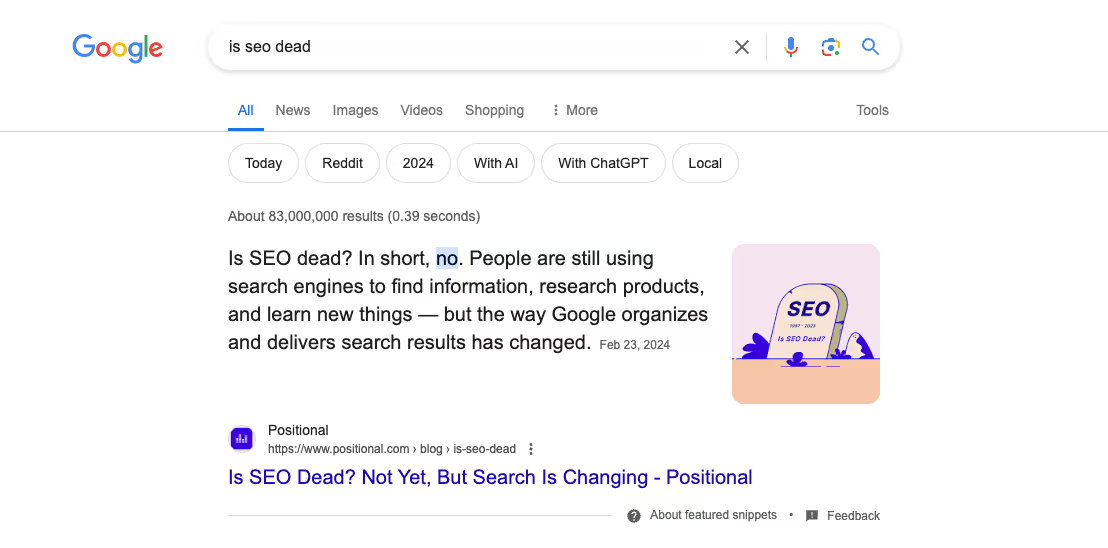
I have a love-hate relationship with featured snippets, as I do with other SERP features like People Also Ask.
If you’ve landed a webpage in the featured snippets section, you’re likely driving more traffic to that page than you would otherwise. However, some data suggests that when a featured snippet appears on a SERP, the results on that page get fewer clicks (more on that later).
Google released featured snippets in 2014 to help searchers get answers to their questions faster. Over the years, featured snippets have risen and fallen in popularity, and today, depending on whom you ask, you’ll see that featured snippets appear in roughly 6% to 15% of all search results, often for long-tail keywords. However, given the recent and predicted changes to organic search as a result of AI, it’s unclear how much longer featured snippets will be relevant to search results.
That being said, featured snippets are very relevant today. If you’re lucky enough to score one, your webpage might experience a significant bump in traffic — often two to three times as much traffic, in my experience.
In this article, I’ll provide a bit more context on how featured snippets work, highlight some very interesting data regarding their placements, recap the types of featured snippets, and provide some quick tips for optimizing your content for them.
How Important Are Featured Snippets?
They may not be as important as they used to be. Or are they? What about SGE (Search Generative Experience)?
While it’s hard to stitch together a complete picture, some data suggests that featured snippets generally show up in fewer search results than they used to.
In 2017, Ahrefs put out a wonderful study on featured snippets. They found that 12.29% of search queries returned search results with featured snippets.
But over the years, I’ve noticed a decrease in the number of featured snippets included in my own search results. And as of this writing, data from Semrush suggests that featured snippets appear in only 5.8% of search results for searchers located in the U.S.
Then again, data from RankRanger suggests that featured snippets are appearing in 15.03% of search results as of this writing.
So let’s assume that featured snippets appear in something like 6% to 15% of search results.
The same Ahrefs study found that, on average, 8.6% of clicks go to the featured snippet when one is shown, well below the percentage of clicks that the first search result typically gets (19.6%, according to Ahrefs). And when a featured snippet is shown, the percentage of clicks on the SERP’s results decreases, on average, from 74.2% to 70.2%.
Ahrefs found that 99.58% (or more) of the time, Google will pull only one of the existing search results on the first page of the search into the featured snippet position.
So for websites that might currently be appearing in the middle or bottom portion of the first page, a featured snippet position could mean significantly higher click-through rates. Backlinko found that click-through rates are typically lower than 8.6% for search results below the third spot on SERPs.
However, for a website currently ranking first, second, or third for a given keyword, the featured snippet position could result in less traffic from organic search.
Are Featured Snippets Dying?
Featured snippets were introduced to provide searchers with faster answers to their questions. In 2023, Google announced SGE to provide faster, AI-generated, answers to search queries:

Like featured snippets, SGE placements appear at the top of search results. Moreover, SGE placements also provide links back to publishers within the placements. But with SGE, Google tends to provide multiple links back to publishers, while with featured snippets, Google provides only a single link.
As I discussed with Eli Schwartz on the Optimize podcast, it’s unclear whether or when SGE is going to be released everywhere; one could speculate that SGE placements would replace featured snippets for many search queries or even entirely.
4 Types of Featured Snippets
There are four different types of featured snippets to be aware of.
Paragraphs
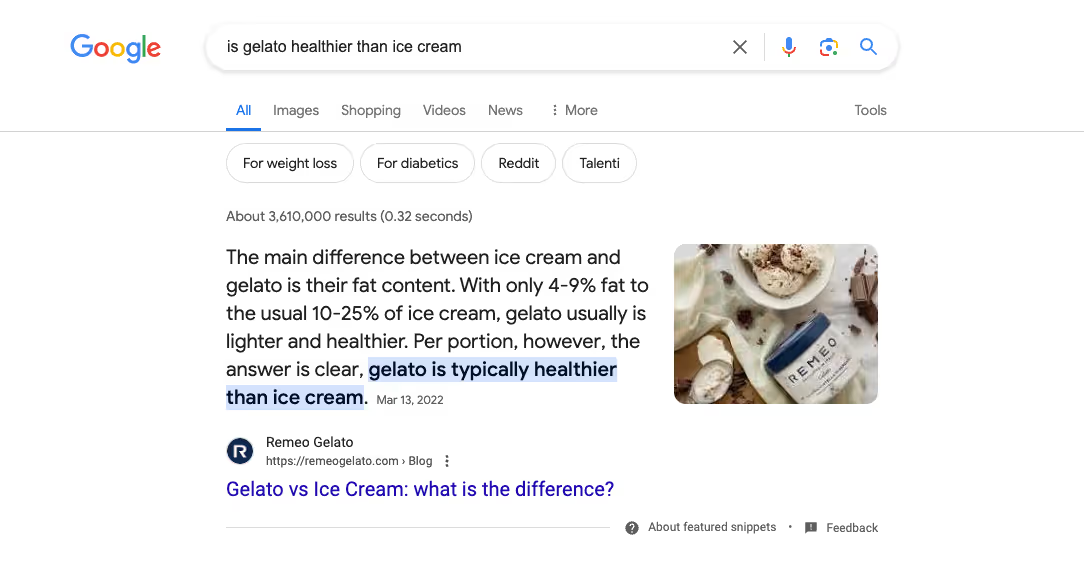
This featured snippet is an example of a paragraph snippet. I’ve asked Google a question, and it has given me a direct answer, along with some additional context to support the answer.
If I click on the link below the featured snippet, Google takes me directly to the relevant section of the webpage they extracted the snippet from:
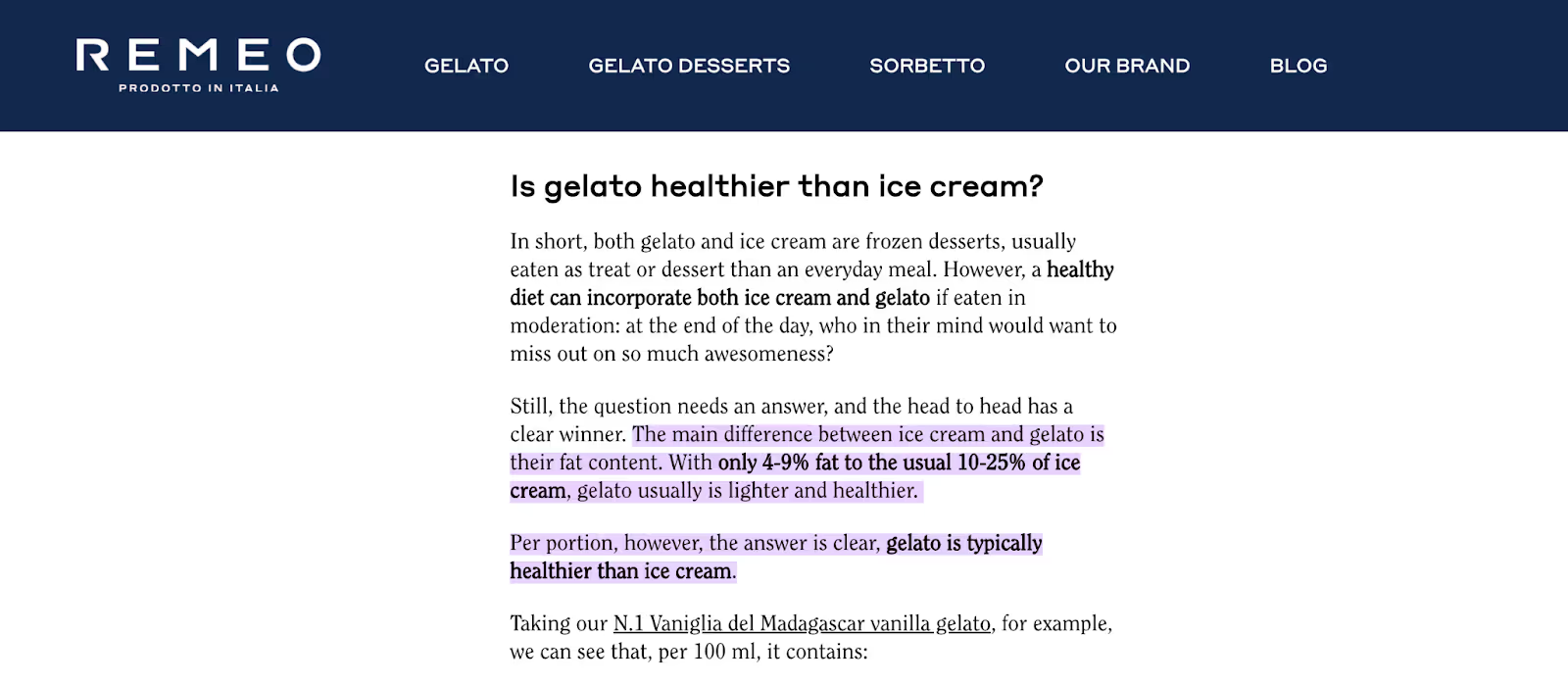
And as seen above, Google then highlights the snippet in light purple. For a keyword like this, I would assume that the featured snippet is reducing some clicks from publishers. However, with this query, the searcher might have more specific questions — for example, about fat content — and might still be interested in exploring further.
Here’s another example of a paragraph featured snippet, a more extreme one:

Again, I’ve asked Google a question with my search query — and in this case, my question is being answered directly and pretty completely. There’s a low likelihood that a searcher would need to click further into this result, and I’d imagine that publishers are experiencing fewer clicks as a result of this snippet.
Lists
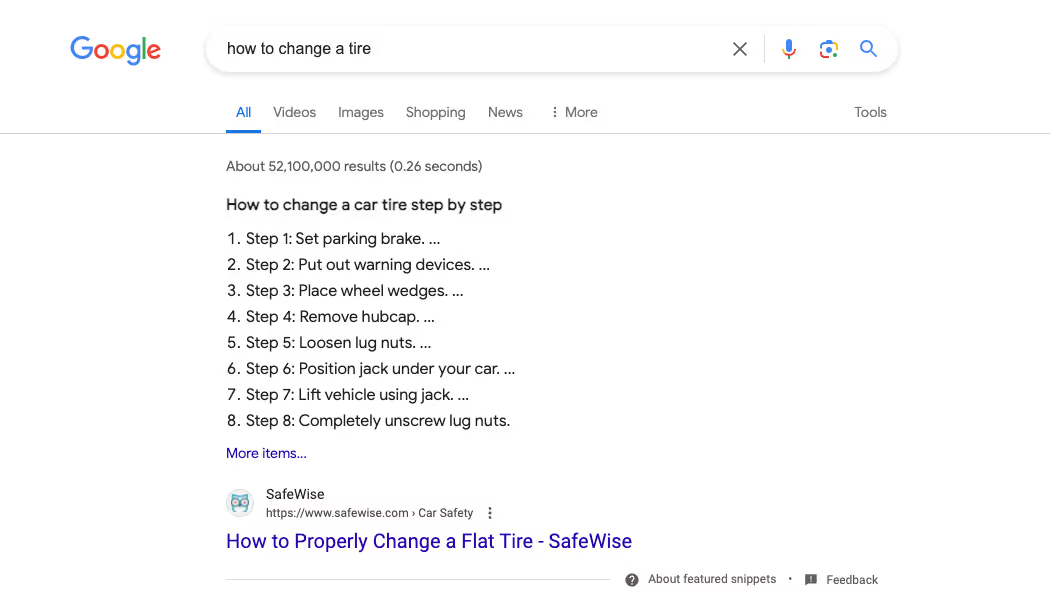
Fortunately, I’ve never had to change a tire, but in this featured snippet, Google provides a list of the steps for doing so.
In this example, Google is pulling the headers, specifically the H3s, from this search result:
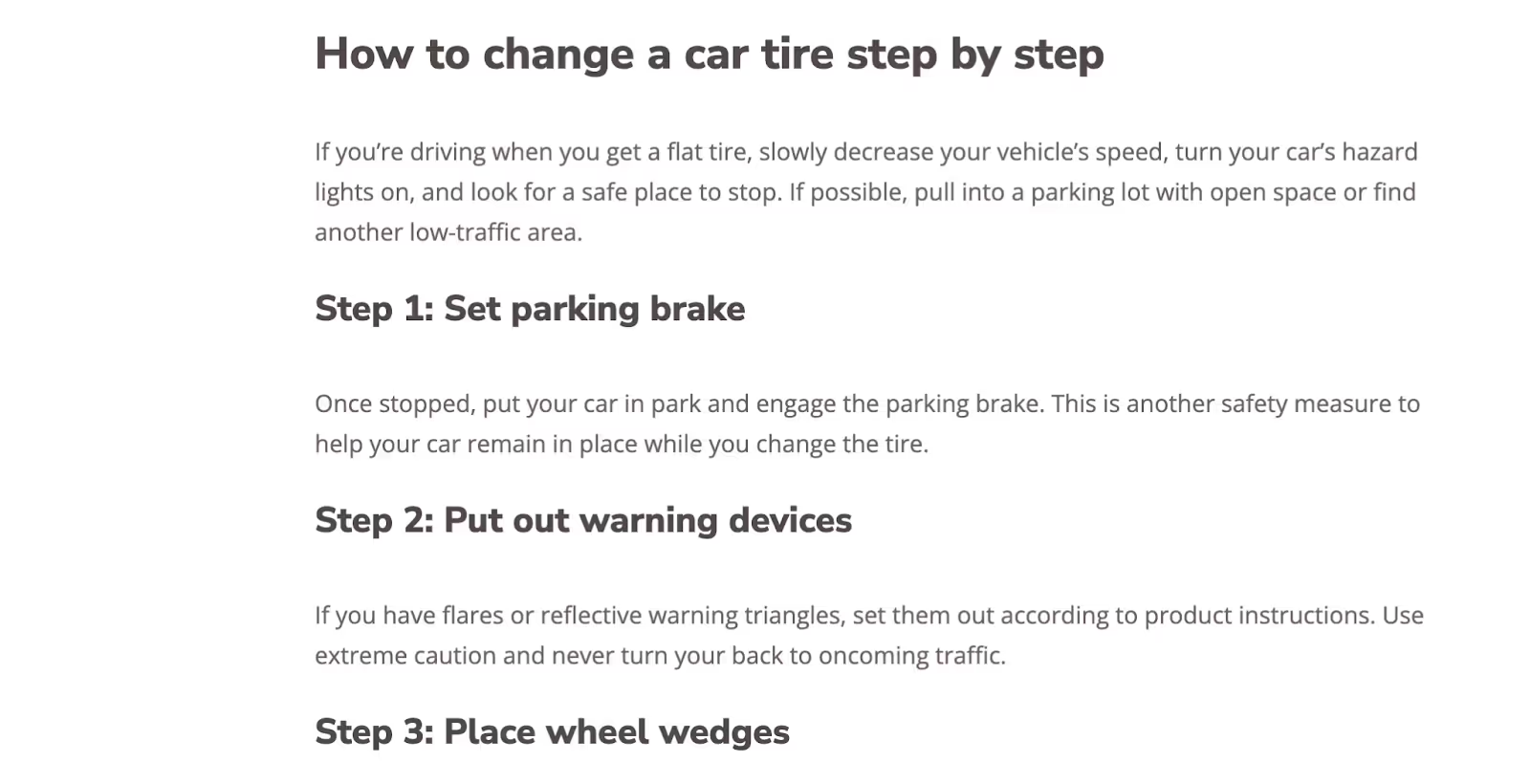
If you were targeting this keyword, you might not actually need to add an ordered list to your webpage, but you’d probably want to optimize your headers in order, as this top search result has done.
With this keyword specifically, I don’t imagine that they’re losing out on too many clicks as a result of the SERP’s featured snippet, given that the topic is fairly complex. And to be honest, there’s no way that I would be able to actually change a tire simply by looking at this featured snippet.
Tables

Tables don’t appear nearly as often within featured snippets, but every once in a while, I’ll stumble upon one. In this case, I searched for car sales by model in 2019, and Google provided a table view quickly, showing me the four top-selling models.
Google is pulling this table directly from a webpage, and clicking on the “115 more rows” button, as seen above, actually takes you directly to the webpage, too:

What’s interesting here is that the featured snippet actually got it wrong. In the featured snippet, they highlighted the Honda CR-V as the leading model, but it was actually the Ford F-Series that had the most sales.
If a searcher notices that the featured snippet is displaying inaccurate or misleading information, they can provide feedback by clicking on the Feedback button and submitting this form:
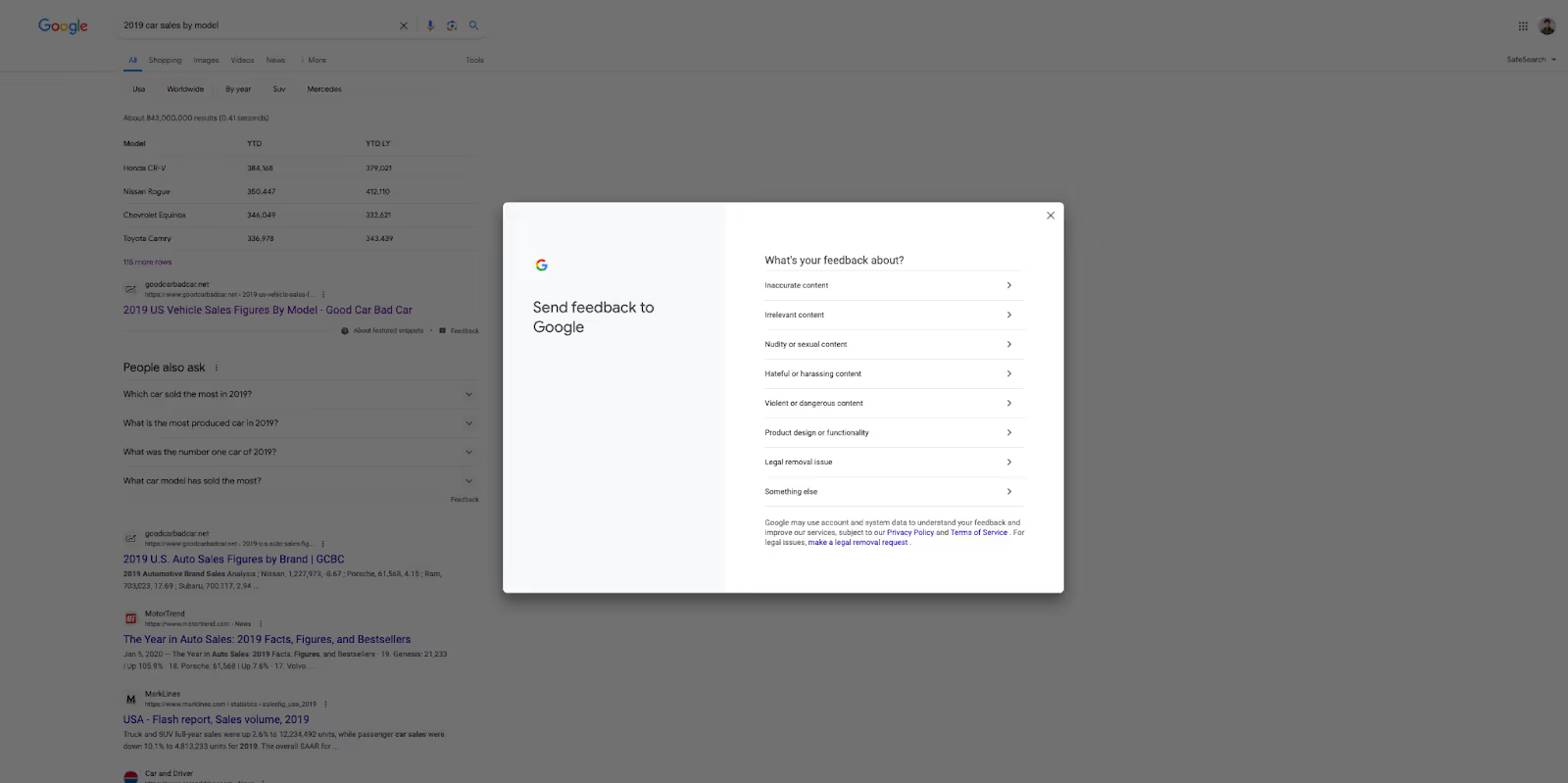
Videos

Once in a while, you’ll see videos from YouTube in the featured snippet section, too! In this case, I searched for “how to tie a tie,” which seems like a fairly visual exercise, so Google has determined that I’d be best served with this quick video instead of a piece of blog content.
If you click on the play button, Google actually pops the video out for you directly from the SERP:

If you click on the link, Google takes you directly to YouTube, where the video is hosted.
In general, videos are quite helpful for searchers and can improve engagement metrics, as explained by Aakash Shah on the Optimize podcast: “The written pages were getting some rankings, but they weren't really very high up. When we added the video, what we really realized is people engage with video in a different way than they engage with text on a page. And so the videos were just, like, really crushing it when it came to engagement, and, like, people felt like they were getting their answer faster, and I think that's how video really helps.”
Optimizing for Featured Snippets
Optimizing for featured snippets is a gamble in terms of time spent. But there are a few approaches that can give a webpage a better chance of securing that top spot.
Match Your Page to the Current Featured Snippet Format
Earlier in this article, we highlighted some featured snippets, such as tables and lists.
If you’re targeting a featured snippet spot, you’ll want to ensure that your webpage has elements that align with what the featured snippet is currently displaying.
For example, if the featured snippet for a given keyword is currently displaying a comparison table, you’d want to include a similarly designed comparison table within your piece of content. As another example, if the current featured snippet is displaying a list of items taken directly from an ordered list, you’d want to incorporate an ordered list into your webpage.
At Postional, when we create our content outlines, we note the primary keyword and secondary keywords that our page should serve. If we notice that a featured snippet is currently being displayed for the primary keyword or one of the higher search volume secondary keywords, we often try to outline a section within our piece to match the format of what’s already being displayed.
Target Long-Tail Keywords
In their aforementioned study, Ahrefs found that featured snippets tended to appear more often for keywords with lower keyword search volume, which are often described as long-tail keywords. According to Ahrefs, 54% of featured snippets appear for search queries where the monthly search volume is lower than 50 searches per month.
Target Comparison Keywords
Featured snippets will often appear when a searcher is looking to compare multiple things.
According to Ahrefs data, SERPs for keywords including phrases like “best,”, “vs.” or “versus,” and “review” will often include featured snippets.
I’ve always loved these comparison keywords because they are often fairly high intent from a conversion point of view. And “vs.” keywords, in particular, are a little easier from a competition point of view.
Focus on Keywords Where Featured Snippets Appear Today
Creating your own featured snippet is totally doable, but it’s often easier to steal featured snippets from other search results.
Of course, you can manually track featured snippets by noting them in a spreadsheet as you see them appear in search results or as you create a content outline for a new piece of content.
However, several SEO tools allow you to track and identify featured snippets at scale. Two popular SEO tools, Ahrefs and Semrush, allow you to filter and screen keywords within their keyword research tools for featured snippet existence. These tools will also track your search engine rankings, including whether you’re currently placed within a featured snippet.
Final Thoughts
Love them or hate them, featured snippets are fairly common on SERPs today. While the future is unclear with the rollout of experiences like SGE, if you’re currently ranking below position three for an important keyword, know that getting that featured snippet placement will likely increase your website's traffic.
You can optimize for featured snippet placement, as discussed at length in this article. We do build feature snippet optimization into our content outline process, but my general approach is always to do what’s best for the searcher.
If, by adding a helpful table or video, for example, to a piece of blog content, you’ll provide a better experience for searchers, I’d say go for it, regardless of whether or not it puts you in position 0.
%20What%20are%20Features%20Snippets.avif)




